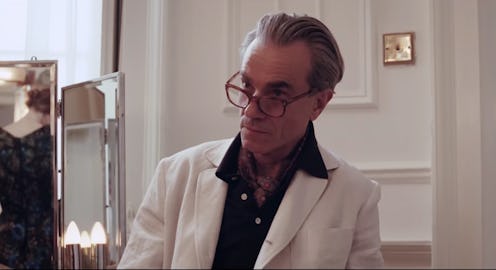Entertainment
If You're Obsessed With The Fashion Industry, See The New Movie 'Phantom Thread'
After the intensity of There Will Be Blood, movie buffs eagerly awaited the latest collaboration between director Paul Thomas Anderson and actor Daniel Day Lewis, Phantom Thread. Now that the film is out, fans aren't disappointed, but they are left with some big questions. Anderson's character study, set in the world of 1950s fashion, will evoke the behaviors of certain famous designers, but is Phantom Thread based on a true story? Actually, the director's inspiration for the film came not from reality, but from some surprising sources.
In the movie, Lewis plays detail-obsessed dress designer Reynolds Woodcock, who runs his own house of couture with the help of his unusually close business partner/sister Cyril. He meets his match in his latest muse, Alma, and their test of wills is the film's main focus. Meanwhile, swirling around is the busy and tight-knit world of high fashion — skilled seamstresses meticulously stitching intricate details, pampered clients being wooed, and cutthroat competition for both talent and patrons.
It seems a far cry from the blood and dust of There Will Be Blood, or the hypermasculine ranting of Magnolia's Frank Mackey. Anderson himself admitted in an Entertainment Weekly interview, "I generally didn’t have that much knowledge or interest in the fashion world until I started finding out a little bit about a guy named Cristóbal Balenciaga." That's a pretty casual way to refer to a man called "the master of us all" by no less than Christian Dior, and who to this day is considered the apex of European fashion design.
Balenciaga and the fictional Woodcock have a great deal in common, including reputations as uncompromising masters of their craft, able to design, cut and sew models for their work, the highest achievement of the art. Both started sewing young, learning at their seamstress mothers' feet, and had early and continued support from aristocrat patrons — Balenciaga's real-life Marchioness de Casa Torres sent him to Spain for formal tailoring training. Both had the privilege of making a royal wedding dress, in Balenciaga's case for Fabiola de Mora y Aragón when she married King Baudouin I of Belgium.
Where they differ are in the more personal aspects of their lives. Balenciaga's lover was his long-time partner, milliner Vladzio Jaworowski d'Attainville, and Balenciaga was so traumatized by his death he considered closing down shop entirely, according to the book The Master of Us All by Mary Blume. Woodcock, meanwhile, cycles through a series of young muses, and has his sister get rid of them when he tires of them. That is, until Alma shows up. She's strong-willed as he is, which takes Woodcock aback. Their back-and-forth struggle is desperate and necessary; they need what the other has and wants to give them, but despise their own wanting it.
Ultimately they both recognize the dramatic cycle of ups and downs is actually part of their relationship, the swapping of control and controlled a way to restore balance and harmony temporarily before they dive into challenging each other again. Without the challenge they'd get bored, without the calm, they couldn't remain together. For a director reluctant to speak directly about his own work and process, Anderson has admitted this intense dynamic comes straight from true life as well.
In an interview with Rolling Stone, Anderson spoke of his being ill, and cared for by his wife, multi-talented actor Maya Rudolph. Anderson said, "I had this thought: "Oh, she is looking at me with such care and tenderness ... wouldn't it suit her to keep me sick in this state?" The idea of a physical component to the mental balance of power in a long-term relationship was the spark that ignited what became Phantom Thread, a directly personal note from a director normally observing at a distance.
Phantom Thread screens in 70mm at select theaters, same as with The Master — an outsize format that highlights every potential flaw, or in the case of a detail obsessed creator, attention to perfection. Indeed, the same elements of Woodcock and Balenciaga also apply to Anderson: detail-obsessed, focused exactly on what they want to focus on, and moving on completely once they're over something. This time around, the extremely personal root of Phantom Thread has made the creator/creative relationship a two-way influence.
In the same Rolling Stone interview Anderson noted that he'll throw himself into film research, amass a volume of work, and once the film's over, it's done. With Phantom Thread, though, he was bitten by the fashion bug. "Now, I still check out Vogue online and see what people are up to. I still love it," he said. It's a fitting obsession that puts Anderson in the excellent company of his inspiration and own creation.
